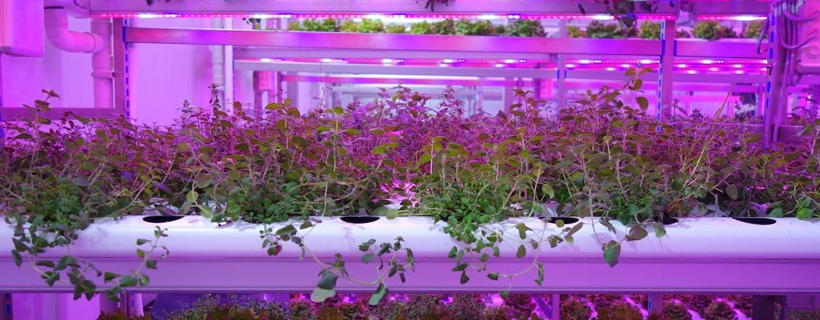- Due to advancements in technology, as well as consumers’ growing appetite for locally grown leafy greens and vegetables that are both high in nutritional value and come with improved taste, an evolution is underway in the agriculture space.
- This is changing the way produce is produced, and where it is being grown.
- This new method is called Indoor Ag, commonly known as Controlled Environment Agriculture (CEA).
- We see Indoor Ag as an attractive investment opportunity and believe frontier tech will play a prominent role in this flourishing market.
Why now?
According to Indoor Farm Economics, there were 15 commercial-scale Indoor Ag farms in the US in 2016. In Spring 2017, there were 56, and the number continues to grow at a healthy rate. While Indoor Agriculture is not new and has been most recently used to grow cannabis, farmers are beginning to explore these methods because of the quality and cost benefits it offers consumers, as well as consumers growing concern over food safety. In addition, technological innovations have improved profitability and are beginning to create a more sustainable method over traditional processes as the world population continues to grow. For these reasons, we see indoor ag as an attractive investment opportunity and believe frontier tech will play a prominent role in its rise.
Industry overview
Indoor agriculture is the process of growing produce using hydroponics, aquaponics, and aeroponic techniques in standardized form factors such as warehouses, greenhouses, and containers. Today, indoor agriculture farms primarily produce leafy greens, microgreens, herbs, and tomatoes. In addition, strawberries, nutraceutical plants, and pharmaceutical plants are under intense R&D and are now starting to come to market. The biggest advantages of moving to an Indoor Ag model, include:
- Year-round availability of any and all produce items at competitive wholesale pricing.
- Time to market is measured in hours versus days contributing to a better, more nutritious product that tastes better and minimizes transportation costs and carbon emissions.
- Superior “science” of growing can be applied using advanced LED lighting, controls, and mechanisms to guarantee a perfect crop every time regardless of outside weather or location.
- Grown without chemicals and drastically more efficient use of water plus ability to recapture/recycle.
These CEA advantages improve food safety and sustainability. However, the industry still has a long way to go until Indoor Ag becomes mainstream. The biggest challenges holding this up include:
- The lack of capital from banks and VCs that will invest in this theme.
- Gaining sufficient scale to service accounts like a Wal-Mart.
- Concerns around profitability due to the limited size of the growing building.
Key frontier tech
The emergence of Indoor Ag startups creating innovative tech has been a material catalyst to adoption and improving profitability. Specifically, technological advancements around LEDs, robotics, and genomics have helped meaningfully.
- Excessive heat can be incredibly damaging to plants. GrowFilm, a Minnesota startup (growfilm.ag), has developed light emitters that operate around 93º F, allowing them to be placed closer to plants. This also eliminates the need for multiple lamps and lighting systems, which can increase yields by 40%. Additionally, a better understanding of how photosynthesis is impacted by different light spectrums is allowing Indoor Ag locations to work with cost-effective LEDs to further “tune” their grow recipe.
- Given indoor robotics is considered a “lab” environment by the US Labor Department, personnel requirements are more stringent than the migrant workers used to pick 70%+ of the nation’s produce. In addition, rising farm wages and labor shortage have been headwinds. Advancements in robotics and artificial intelligence have lowered the cost of labor and increased productivity. This includes cameras and sensors to enhance grow cycles and provide real-time feedback. Tortuga AgTech is a startup developing robotic systems for harvesting fresh produce in controlled environments.
- Advanced indoor farmers are turning their attention to how they can create seeds that are better designed for indoor systems, producing higher yields. Some are turning to heirloom seeds because they cost less and produce more nutritious foods than hybrid seeds, which are the primary seeds used in traditional agriculture.
Indoor Ag economics
One of the arguments against indoor farms historically has been the limited size of the growing form factor, and many struggled to reach profitability. While this was a challenge, the technological improvements discussed above, new CEA farms capable of producing over one million leafy green products per month, recycling resources, and lowering transportation costs are making indoor ag economics very favorable. Another advantage of indoor ag is it is less exposed to the cyclical nature of traditional agriculture due to the ability to steadily produce the same amount all year long. Plus, given labor shortages to harvest field grows, the dynamics of CEA farming become compelling.
Venture committed to this theme growing
While receiving capital has been another challenge for indoor farmers, VC dollars increased 3-fold in 2017 to $300M year/year. This was primarily driven by Softbank’s $200M investment into Plenty, which also included an investment from Jeff Bezos. We think the opportunity in indoor agriculture is large and believe it is an attractive theme for frontier technology over the next decade.
Disclaimer: We actively write about the themes in which we invest: virtual reality, augmented reality, artificial intelligence, and robotics. From time to time, we will write about companies that are in our portfolio. Content on this site including opinions on specific themes in technology, market estimates, and estimates and commentary regarding publicly traded or private companies is not intended for use in making investment decisions. We hold no obligation to update any of our projections. We express no warranties about any estimates or opinions we make.
